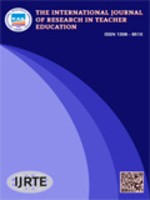What are the Pre-service Chemistry Teachers’ Explanations on Chemistry Topics?
What are the Pre-service Chemistry Teachers’ Explanations on Chemistry Topics?
Keywords:
-,
___
- Akkus, H., Kadayıfcı, H., Atasoy, B. & Geban, O. (2003). Effectiveness of instruction based on the constructivist approach on understanding chemical equilibrium concepts. Research in Science & Technological Education, 21 (2), 209-227.
- Ausubel, D. P. (1968). Educational psychology: A cognitive view. New York: Holt, Rinehard and Winston.
- Aydemir, N., Bektaş, O, Çetin-Dindar, A., Aydın, S., & Boz, Y. (2008). Development of Pre-service Chemistry Teachers’ Understanding of Particulate Nature of Matter. A paper presented XIII.IOSTE Symposium, September 21-26, İzmir, Türkiye.
- Aydin, S., Aydemir, N. Boz, Y., Cetin-Dindar, A., & Bektas, O. (2009). The Contribution of Constructivist Instruction Accompanied by Concept Mapping in Enhancing Pre-service Chemistry Teachers’ Conceptual Understanding of Chemistry in the Laboratory Course. Journal of Science Education and Technology, 18(6), 518-534.
- Barke, H.D., Hazari, A., & Yitbarek, S. (2009). Misconceptions in Chemistry- Addressing Perceptions in Chemical Education. Springer, Berlin.
- Bektas, O (2003). The misconceptions of 9th grade students related to the particulate nature of matter, the reasons behind them, and their elimination. Unpublished Master Thesis. Gazi University, Ankara.
- Bektas, O., Çetin-Dindar, A. & Yalcin-Celik, A, (2009). Exploring conceptual integration in the preservice chemistry teachers’ thinking. A paper presented European Science Education Research Association 2009 Conference, August31-September 4, 2009, Istanbul, Turkey. Canpolat, N., Pinarbasi, T., & Sozbilir, M. (2006). Prospective teachers’ misconceptions of vaporization and vapor pressure. Journal of Chemical Education, 83 (8), 1237-1242. Cetin-Dindar, A., Bektas, O, Aydın, S., Aydemir, N. & Boz, Y. (2008). Pre-service Chemistry Teachers’ Misconceptions on Evaporation, Boiling, and Vapor Pressure. A paper presented XIII.IOSTE Symposium, September 21-26, İzmir, Türkiye.
- Coştu, B., Ayas, A., & Ünal, S. (2007). Karam Yanılgıları ve Olası Nedenleri: Kaynama Kavramı. Kastamonu Eğitim Dergisi, 15(1), 123-136.
- Gabel, D. L., Samuel, K.V., & Hunn, D. (1987). Understanding the particulate nature of matter. Journal of Chemical Education, 64(8), 695-697.
- Gabel, D.L. (1999). Improving teaching and learning through chemistry education research: A look to the future. Journal of Chemical Education, 76 (4), 548-554.
- Gómez, E.J., Benarroch, A., Marín, N. (2006). Evaluation of the degree of coherence found in students’ conceptions concerning the particulate nature of matter. Journal of Research in Science Teaching, 43 (6), 577-598.
- Griffiths, A.K., & Preston, K.R. (1992). Grade-12 students’ misconceptions relating to fundamental characteristics of atoms and molecules. Journal of Research in Science Teaching, 29(6), 611628.
- Haidar, A.H., & Abraham, M.R. (1991). A comparison of applied and theoretical knowledge of concepts based on the particulate nature of matter. Journal of Research in Science Teaching, 28(10), 919-938.
- Harrison, A.G. & Treagust, D.F. (1996). Secondary students’ mental models of atoms and molecules: Implications for teaching chemistry. Science Education, 80 (5), 509-534. Herron, D. (1996). The Chemistry Classroom-Formulas for Successful Teaching. American Chemical Society. Washington, DC.
- Jansoon, N., Coll, R.K., & Somsook, E. (2009). Understanding mental models of dilution in Thai students. International Journal of Environmental & Science Education, 4(2), 147-168.
- Mirzaie, R.A., Shahmohammadi, M.,& Kouhi, A. (2010). Study of students’ mental images effect on learning chemistry. Eurasian Journal of Physics and Chemistry Education, 2(1), 53-62.
- Nakhleh, M.B. (1992). Why some students don’t learn chemistry. Journal of Chemical Education, 69(3), 191-196.
- Nakhleh, M.B. & Samarapungavan, A. (1999). Elementary school children’s beliefs about matter. Journal of Research in Science Teaching, 36 (7), 777-805.
- Novick, S & Nussbaum, J. (1981). Pupil’s understanding of the particulate nature of matter: A crossage study. Science Education, 65, 187-196. Powers, A. (2000). Relationships of students’ conceptual representations and problem solving abilities in acid base chemistry. Unpublished Doctoral Thesis, University of Northern Colorado, Colorado.
- Sanger, M.J. & Greenbowe, T.J. (1999). An Analysis of College Chemistry Textbooks as Sources of Misconceptions and Errors in Electrochemistry. Journal of Chemical Education, 76, 853-860.
- Schmidt, H-J. (1995) Applying the concept of conjugation to the Bronsted theory of acid-base reactions by senior high school students from Germany. International Journal of Science Education, 17, 733 -742.
- Schmidt, H. J., Marohn, A., Harrison, A. G. (2007). Factors that prevent learning in electrochemistry. Journal of Research in Science Teaching, 44 (2), 258-283.
- Taber, K. S. (2003). Mediating mental models of metals: Acknowledging the priority of the learner’s prior learning. Science Education, 87, 732-787.
- Taber, K. S. (2008). Exploring conceptual integration in student thinking: Evidence from a case study. International Journal of Science Education, 30 (14), 1915-1943.
- Teichert, M.A., Tien, T.L., Anthony, S., & Rickey, D. (2008). Effect of context on students’ molecular level ideas. International Journal of Science Education, 30(8), 1095-1114.
- Treagust, D.F., Chittleborough, G., & Mamiala, T.L. (2003). The role of submicroscopic and symbolic representations in chemical explanations. International Journal of Science Education, 13531368.
- ISSN: 1308-951X
- Başlangıç: 2010
- Yayıncı: Eğitim Araştırmaları Birliği Derneği
Sayıdaki Diğer Makaleler
An Investigation of Peer-Teaching Technique in Student Teacher Development
Identity and Ethics of the Profession in Eight Countries A Comparative Research
Scaffolding Strategies Applied by Student Teachers to Teach Mathematics
Fatma H. BIKMAZ, Özhan ÇELEB, Aslıhan ATA, Eren ÖZER, Öznur SOYAK, Hande REÇBER
Investigation of Effectiveness of the Pedagogical Education from Mathematics Teachers’ Perceptions
What are the Pre-service Chemistry Teachers’ Explanations on Chemistry Topics?
